
Owen Roberts International Airport is an airport serving Grand Cayman, Cayman Islands. It is the main international airport for the Cayman Islands as well as the main base for Cayman Airways. The airport is named after British Royal Air Force (RAF) Wing Commander Owen Roberts, a pioneer of commercial aviation in the country, and is one of the two entrance ports to the Cayman Islands.

St. Pete–Clearwater International Airport is a public/military airport in Pinellas County, Florida, United States, serving the Tampa Bay Area. It is right on the northeast municipal boundary of Pinellas Park, 9 miles (14 km) north of downtown St. Petersburg, 7 miles (11 km) southeast of Clearwater, and 17 miles (27 km) southwest of Tampa.
Panama City–Bay County International Airport(IATA: PFN, ICAO: KPFN, FAA LID: PFN) was a public airport 3 miles (4.8 km) northwest of Panama City, in Bay County, Florida. It was owned and operated by the Panama City–Bay County Airport and Industrial District. All airline services moved to the Northwest Florida Beaches International Airport on May 22, 2010, but the airfield was open to general aviation aircraft until October 1, 2010. The grounds will eventually be turned over to LUK-MB1 LLC, which plans to remove the runways and build homes, shops, walking trails and a marina.
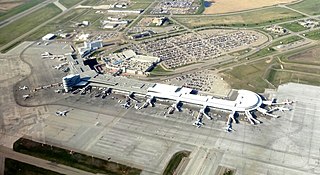
Edmonton International Airport, officially branded YEG Edmonton International Airport since 2022, is the primary air passenger and air cargo facility in the Edmonton Metropolitan Region of the Canadian province of Alberta. Designated as an international airport by Transport Canada and operated by Edmonton Airports, it is located 14 nautical miles south southwest of Downtown Edmonton in Leduc County on Highway 2 opposite of the city of Leduc. The airport offers scheduled non-stop flights to major cities in Canada, the United States, Mexico, the Caribbean, Central America and Europe.

Corpus Christi International Airport is 6 miles west of Corpus Christi, in Nueces County, Texas. It opened in 1960, replacing Cliff Maus airport at 27.767°N 97.44°W, where the Lozano Golf Center is now located.
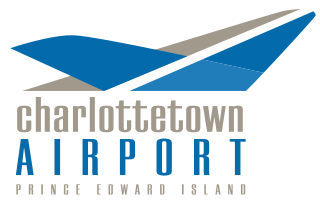
Charlottetown Airport is located 3 nautical miles north of Charlottetown, Prince Edward Island, Canada. The airport is currently run by the Charlottetown Airport Authority, is owned by Transport Canada and forms part of the National Airports System.

Billings Logan International Airport is in the western United States, two miles northwest of downtown Billings, in Yellowstone County, Montana. It is the fourth largest airport in Montana, having been surpassed in recent years by Bozeman, Missoula, and Flathead County (Kalispell) in both number of gates as well as annual enplanements. Owned by the city of Billings, the airport is on top of the Rims, a 500-foot (150 m) cliff overlooking the downtown core, and covers 2,500 acres of land.
Air Ontario Inc. was a Canadian regional airline with its predecessor initially headquartered in Sarnia and later in London, Ontario. In 2002, Air Ontario became Air Canada Jazz.

Time Air was an airline in Canada founded in 1966 by businessman Walter “Stubb” Ross from Lethbridge in Alberta. It was called Lethbridge Air Service before becoming Time Airways Ltd. in 1969, which was later shortened to Time Air Ltd. In 1993 it was merged with Ontario Express to create Canadian Regional Airlines.

Kelowna International Airport is a Canadian airport located approximately 10 minutes or 6.2 nautical miles northeast of Kelowna, British Columbia, Canada, on Highway 97.
Lethbridge Airport, previously Lethbridge County Airport, is located 4 nautical miles south southeast of Lethbridge, Alberta, Canada. It is 10–15 driving minutes from downtown Lethbridge, and has scheduled service to the city of Calgary, Alberta. The airport is classified as an airport of entry by Nav Canada and is staffed by the Canada Border Services Agency (CBSA) on a call-out basis from the Sweetgrass-Coutts Border Crossing. CBSA officers at this airport can handle general aviation aircraft only, with no more than 15 passengers. The airport hosts the biennial Lethbridge International Airshow.

Erik Nielsen Whitehorse International Airport is an airport of entry located in Whitehorse, Yukon, Canada. It is part of the National Airports System, and is owned and operated by the Government of Yukon. The airport was renamed in honour of longtime Yukon Member of Parliament Erik Nielsen on December 15, 2008. The terminal handled 294,000 passengers in 2012, representing a 94% increase in passenger traffic since 2002. By 2017, this number had risen to 366,000. Air North is based in Whitehorse.

Resolute Bay Airport is located at Resolute, Nunavut, Canada, and is operated by the government of Nunavut. It is one of the northernmost airfields in Canada to receive scheduled passenger airline service.

Idaho Falls Regional Airport is two miles north-northwest of downtown Idaho Falls, Idaho, United States. It is locally known as Fanning Field. It is the second-busiest airport in Idaho after Boise Airport.

Juneau International Airport is a city-owned, public-use airport and seaplane base located seven nautical miles northwest of the central business district of Juneau, a city and borough in the U.S. state of Alaska that has no direct road access to the outside world. The airport serves as a regional hub for all air travel, from bush carriers to major U.S. air carriers such as Alaska Airlines.
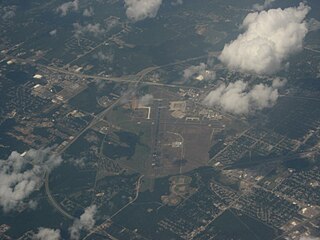
Shreveport Regional Airport is a public use airport in Shreveport, Louisiana, United States. It is owned by the City of Shreveport and located four nautical miles (7 km) southwest of its central business district.

Glacier Park International Airport is in Flathead County, Montana, United States, six miles northeast of Kalispell. The airport is owned and operated by the Flathead Municipal Airport Authority, a public agency created by the county in 1974.

Muskegon County Airport is a county-owned, public-use airport in Muskegon County, Michigan, United States. The airport is located four nautical miles south of the central business district of Muskegon, Michigan, in Norton Shores. It is mostly used for general aviation but is also served by Southern Airways Express flying Cessna 208 Caravan aircraft to Chicago-O'Hare, subsidized by the Essential Air Service program.
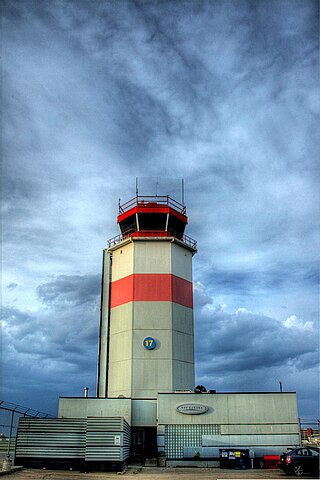
Edmonton City Centre Airport (ECCA), also called Blatchford Field as well as Edmonton Municipal Airport, was an airport within the city of Edmonton, in Alberta, Canada.
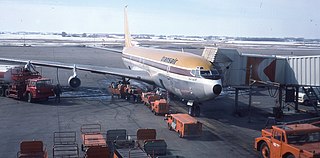
Transair was an airline based in Canada. It was purchased by Pacific Western Airlines in 1979. Transair's operational headquarters was located at the Winnipeg International Airport in Manitoba.
























